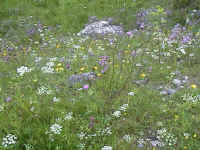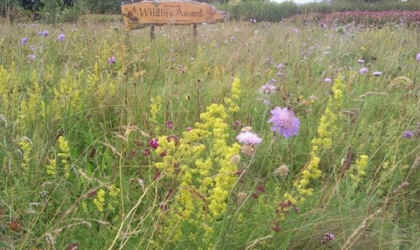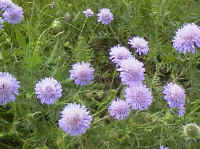| If purchasing this
seed mix, print this page and keep it as your reference.
Native Origin Irish Wildflower
Seed Mixture:
Range: Meadow Mixtures (Code
MM)
Supplied
without grass, Grass seed can be added
Product Name: MM09 Wild
Flora for Dry Limy Soil (alkaline, pH >7)
Product Code: MM09

Description:
Meadow Mixture - MM09 - Dry Alkaline/Limey Soil attracts butterflies & is one of our most beautiful collections of flowers. In
high summer its a field of blue and purple, orange and yellow
This mixture
is a favourite amongst our customers as MM09 forms blocks of tall single species colour capable of surviving
drought.
Especially suited to Athlone region, Meath, Louth, East Roscommon, parts of Galway, Kilkenny, parts of Laois,
parts of Sligo, Carlow. Kilkenny, Tipp and Clare.
Choose this mixture if your site really dries out quickly and often. The stress caused by drought will favour the species herein. Plants growing on
hot dry sites seem to produce more nectar and attract a wider variety of butterflies.
This is a mixture of flora for the lazy wildflower grower to snooze in among the sound of bumble bees and the 'chatter' of butterflies!!!
Mixture Specifications:
Origin: Native Irish Origin, Wildflower Seed
Mixture.
Moisture Level: For very dry soil, suits normal, but not moist or
flooded wet.
pH range: Best between 6.5 - 7.9
Aspect: Sunny
Life Cycle: Annual / Biennial /
Perennial.
Height Range: 30cm - 120cm
Flowering Period: May to August.
Fertility Range: The less fertile the soil, the
less cutting will be required.
Wintergreen: Moderate
Total number of seeds per gram: 1452
This
photograph is one day in the life of an ever changing meadow.

Species
List - :
Field
Scabious, Kidney Vetch, Quaking-Grass, St Johnswort. Musk
Mallow, Red Campion, White Campion, Wild Carrot, Yarrow,
Yellow Agrimony, Yellow Rattle, Salad Burnet, Birdsfoot Trefoil, Black Meddick,
Centaury, Corn Marigold, Corn Poppy, Corn Cockle, Cornflower, Cowslip, Lady's Bedstraw, Lesser Knapweed, Marjoram,
Mullein, Ox-eye Daisy, Red Bartsia, Red Clover, Ribwort Plantain, Selfheal,
additional
species suitable for this soil type may be added if available.
Product
Warning: DBN
recommends that this mixture is not for human or animal consumption.
Sowing Specification:
Soil Preparation:
Normal, create firm, fine tilt on seed bed, if clay, ensure a fine tilt or press the seed into clean soil.
Optimum Sowing Time: Spring, early
autumn, when the soil is warm.
Sowing Conditions:
Normal, roll or rake into surface to
keep out of reach from birds.
Sowing Method: By hand is recommended, if
using seed spreaders be careful to insure the small varieties of seed do
not drop to the bottom of the seed spreader and get sown all in the one
place.
Seed Sowing Rates:
Normal
sowing rate 'without added grass seed':1.5 grams per metre.
High sowing rate 'without added grass seed': Add 3 grams per metre.
Grass
seed or nurse crop requirement:
Nurse
Crop: No nurse crop is required.
Grass Seed Requirement: n/a, use Bent and
Fescue species, Do not use species of Perennial Rye grass
Sow with or without grasses: Either / with grasses /
without grasses
Sowing rate with grasses: 2 to 7 grams per
metre depending on the percentage of grass.
If sown without
grass seed,
this mixture:
Will not require a nurse crop.
Performance:
In normal conditions (mainly in early Autumn and Spring) this mix should
germinate 3 - 6 weeks after sowing, from then on, provided the sward is
kept open and a 'Thatch'
is not allowed develop, species will continue to germinate and emerge,
through to the third year.
First Year:
The
annuals supplied in this mixture will
flower profusely, provided they are sown before June. This mixture requires one cut when finished flowering.
Second Year: In the second year the biennials
will also be very colourful.
If this mixture was not cut in first year, cut
and remove foliage in early Spring. Cut again in July, August or September,
depending on when flower finish or the level of weeds that emerge.
In the third year this meadow mixture will seem
to have less flora than the first and second year. Why?
The perennial species are still young, many will only have
germinated in the second season. However,
there should be identifiable foliage and some flowers. If not contact
us.
If the native grass seeds present in your soil grow vigorously, the meadow will require two
or three cuts, the first cut in Spring (April/May) and the second cut in July or August, the meadow can again be
cut in September if the grasses are still growing strong.

When
should this meadow be established and require one cut?
In the fourth year, when the perennials in the mixture should be flowering on
many stems and starting to clump and spread, again if the grass is still
vigorous cut in spring and in August of the fourth year. However if the
perennials are growing strong there will be no need to cut until July,
August or September depending on the fertility and wetness of the soil
and the species which have grown.
A
wildflower meadow should last many years, provided the wildflower species
were correctly
established, weeds were controlled and the meadow was cut and the cut
material removed and occasional 'Gaps'
are created. If not contact DBN.
Persistence if unmanaged: Moderate
Tolerance of Cutting: High after second year.
General Cutting Time: Mid to end of Summer and again in
spring if required.
Specific Cutting Time: Mid August, wait 3 weeks until after the last flush
of flowers fade away, after seeds set.
Disposal
of cut materials: Always remove the
cuttings, wildflower meadow hay should be removed as soon as possible
and not be heaped on site as it will grow mouldy (a health risk).
Meadow cuttings can be spread as compost in sheet mulches around trees
and shrubs or composted.
Management: Control grasses and weeds until
well established. Accept any normal non-invasive weeds as they provide cover,
once the sward is established, digging, spot spraying or weed wiping can
be used to eliminate problem species.
Most species in this mixture
are 'Browse' resistant.
A
General Description of Range:
Meadow Mixtures are
designed to grow on soil in specific situations.
This range of seed mixture is ideal for those concerned with species suitability,
composition and performance to be attractive, encourage wildlife and local biodiversity.
If these mixtures are suitable for your situation, they offer good value
and if
given time, develop into a flora that will persist if properly maintained.
Your purchase:
Contributes to DBN's work of creating crops
of Conservation Grade - Native Origin Wildflora. You help us to inform
and pay land-owners to manage native species and to assist DBN in
handing on our heritage for another generation.
By growing (some will be difficult) these and all other species, you
directly help to conserve national and global Biodiversity and protect
wildlife. You should also consider yourself another Irish wildflower
grower.
|


